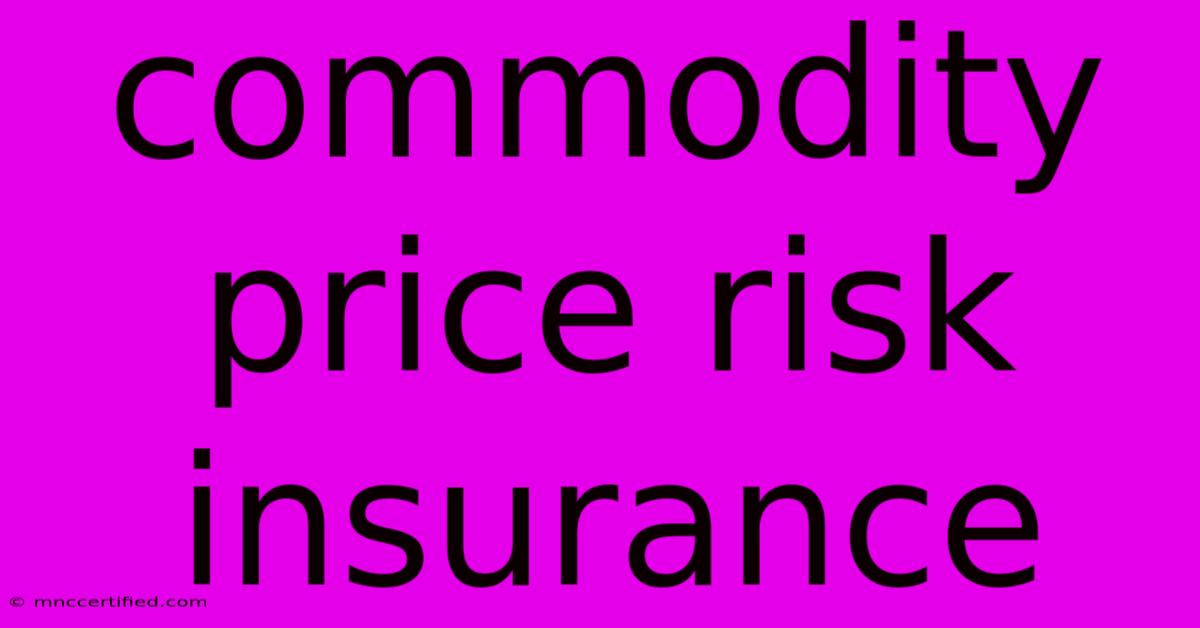Commodity Price Risk Insurance

Table of Contents
Commodity Price Risk Insurance: Protecting Your Business from Market Volatility
Commodity prices are notoriously volatile. A sudden spike or crash can devastate businesses reliant on raw materials, agricultural products, or energy resources. This is where commodity price risk insurance steps in, offering a crucial safety net for businesses exposed to these fluctuations. This comprehensive guide will delve into the intricacies of this vital risk management tool.
Understanding Commodity Price Risk
Before exploring insurance solutions, it's vital to grasp the nature of commodity price risk. This risk stems from unpredictable shifts in market prices influenced by various factors:
- Supply and Demand: Global events, weather patterns, geopolitical instability, and production issues all impact the balance of supply and demand, directly affecting prices.
- Geopolitical Factors: International conflicts, trade wars, and political instability in key producing regions can drastically alter market dynamics.
- Economic Conditions: Recessions, inflation, and changes in consumer spending patterns influence commodity demand and, consequently, pricing.
- Technological Advancements: Innovations in production, processing, or alternative resources can significantly impact commodity prices.
Types of Commodity Price Risk Insurance
Several types of insurance cater to different aspects of commodity price risk:
1. Futures and Options Contracts: Hedging Your Bets
Futures and options contracts are powerful hedging tools. They allow businesses to lock in future prices for commodities, mitigating the risk of price increases. However, they require a sophisticated understanding of derivatives markets and carry their own inherent risks. Note: This isn't strictly "insurance" in the traditional sense but a vital risk management strategy.
2. Commodity Price Insurance Policies: Transferring the Risk
Traditional insurance policies, offered by specialized insurers, provide a direct financial payout if commodity prices fall below a pre-agreed level or rise above a specified ceiling. These policies offer a more straightforward approach than derivatives, though they may be less flexible.
3. Revenue Insurance: Protecting Your Bottom Line
Revenue insurance focuses on protecting a business's overall revenue rather than solely on commodity prices. It considers factors like yields and production levels alongside price fluctuations, providing broader risk coverage.
Benefits of Commodity Price Risk Insurance
Implementing a robust commodity price risk management strategy, including insurance, offers numerous benefits:
- Predictability and Stability: Insurance provides financial certainty, allowing businesses to better forecast their budgets and plan for the future.
- Reduced Financial Vulnerability: It cushions the blow of unexpected price swings, preventing catastrophic losses that could cripple the business.
- Enhanced Access to Credit: Lenders often view businesses with comprehensive risk management strategies more favorably, making it easier to secure loans and credit facilities.
- Improved Competitiveness: By mitigating price risks, businesses can remain competitive, even during periods of market turmoil.
- Strategic Planning: Insurance allows businesses to focus on core operations instead of constantly worrying about volatile commodity markets.
Choosing the Right Commodity Price Risk Insurance
Selecting the appropriate insurance policy depends on various factors:
- Type of Commodity: Different commodities have different price volatility profiles, influencing insurance needs.
- Business Size and Structure: The scale of operations dictates the level of coverage required.
- Risk Tolerance: Businesses with a higher risk tolerance might opt for less comprehensive, but potentially cheaper, options.
- Insurance Provider: Carefully compare policies and pricing from multiple reputable insurance providers.
Beyond Insurance: Proactive Risk Management
While insurance offers a crucial safety net, a proactive approach to risk management is equally essential:
- Market Analysis: Regularly monitor commodity markets, analyzing trends and potential risks.
- Diversification: Reduce reliance on a single commodity source or supplier.
- Efficient Production: Optimize production processes to improve yields and reduce costs.
- Strong Supplier Relationships: Develop strong, reliable relationships with suppliers to ensure a stable supply chain.
Conclusion:
Commodity price risk insurance is not a luxury but a necessity for businesses operating in volatile markets. By understanding the available options and integrating insurance into a broader risk management strategy, companies can safeguard their financial future and ensure long-term sustainability. Remember to consult with financial professionals and insurance experts to determine the best approach for your specific circumstances.

Thank you for visiting our website wich cover about Commodity Price Risk Insurance. We hope the information provided has been useful to you. Feel free to contact us if you have any questions or need further assistance. See you next time and dont miss to bookmark.
Featured Posts
-
Live Manchester City Vs Feyenoord Ucl
Nov 27, 2024
-
Social Protection And Health Equity Webinar
Nov 27, 2024
-
Conversational Ai In Insurance
Nov 27, 2024
-
Value Guard Property Insurance
Nov 27, 2024
-
8 Missing After Egypt Red Sea Boat Accident
Nov 27, 2024